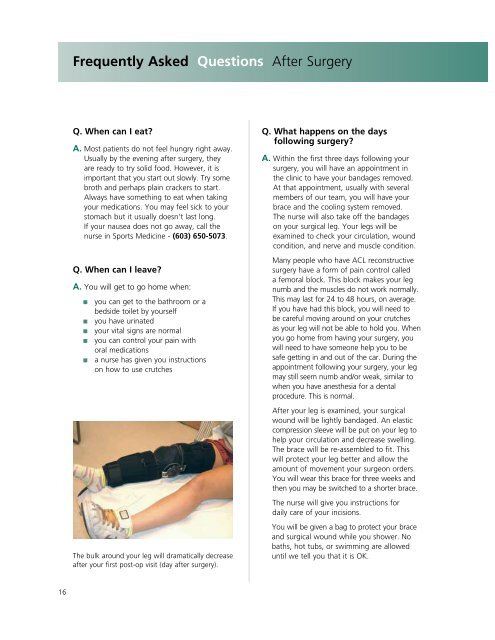ACL Reconstruction Guidebook (2.2MB) - Dartmouth-Hitchcock
ACL Reconstruction Guidebook (2.2MB) - Dartmouth-Hitchcock
ACL Reconstruction Guidebook (2.2MB) - Dartmouth-Hitchcock
Create successful ePaper yourself
Turn your PDF publications into a flip-book with our unique Google optimized e-Paper software.
16<br />
Frequently Asked Questions After Surgery<br />
Q. When can I eat?<br />
A. Most patients do not feel hungry right away.<br />
Usually by the evening after surgery, they<br />
are ready to try solid food. However, it is<br />
important that you start out slowly. Try some<br />
broth and perhaps plain crackers to start.<br />
Always have something to eat when taking<br />
your medications. You may feel sick to your<br />
stomach but it usually doesn’t last long.<br />
If your nausea does not go away, call the<br />
nurse in Sports Medicine - (603) 650-5073.<br />
Q. When can I leave?<br />
A. You will get to go home when:<br />
■ you can get to the bathroom or a<br />
bedside toilet by yourself<br />
■ you have urinated<br />
■ your vital signs are normal<br />
■ you can control your pain with<br />
oral medications<br />
■ a nurse has given you instructions<br />
on how to use crutches<br />
The bulk around your leg will dramatically decrease<br />
after your first post-op visit (day after surgery).<br />
Q. What happens on the days<br />
following surgery?<br />
A. Within the first three days following your<br />
surgery, you will have an appointment in<br />
the clinic to have your bandages removed.<br />
At that appointment, usually with several<br />
members of our team, you will have your<br />
brace and the cooling system removed.<br />
The nurse will also take off the bandages<br />
on your surgical leg. Your legs will be<br />
examined to check your circulation, wound<br />
condition, and nerve and muscle condition.<br />
Many people who have <strong>ACL</strong> reconstructive<br />
surgery have a form of pain control called<br />
a femoral block. This block makes your leg<br />
numb and the muscles do not work normally.<br />
This may last for 24 to 48 hours, on average.<br />
If you have had this block, you will need to<br />
be careful moving around on your crutches<br />
as your leg will not be able to hold you. When<br />
you go home from having your surgery, you<br />
will need to have someone help you to be<br />
safe getting in and out of the car. During the<br />
appointment following your surgery, your leg<br />
may still seem numb and/or weak, similar to<br />
when you have anesthesia for a dental<br />
procedure. This is normal.<br />
After your leg is examined, your surgical<br />
wound will be lightly bandaged. An elastic<br />
compression sleeve will be put on your leg to<br />
help your circulation and decrease swelling.<br />
The brace will be re-assembled to fit. This<br />
will protect your leg better and allow the<br />
amount of movement your surgeon orders.<br />
You will wear this brace for three weeks and<br />
then you may be switched to a shorter brace.<br />
The nurse will give you instructions for<br />
daily care of your incisions.<br />
You will be given a bag to protect your brace<br />
and surgical wound while you shower. No<br />
baths, hot tubs, or swimming are allowed<br />
until we tell you that it is OK.


